By KATIE WORKMAN (AP) – I might never have fallen in love with kohlrabi had I not joined a CSA.
Signing up for a Community-Supported Agriculture program means getting a box of produce from local farms every week or two. It’s a way to take advantage of summer’s bounty, discover new fruits and vegetables, and support the folks who grow food in your area.
The basic idea: Customers buy a “share” of a farm’s harvest before or at the beginning of the growing season. That helps the farmers with cash flow, and the customer is rewarded with fresh, seasonal food and good value.
There are thousands of CSAs around the U.S. A share typically costs somewhere between $400 and $700 for the season, depending on its size, the items included and how long the growing season lasts. Sometimes, the food is delivered — usually weekly — either to your home or to a communal pickup spot. (I took part in one at my office, and another at my kids’ school.) Sometimes people pick up their shares at the farm.
Besides produce, farmers might also include items such as honey, meat, flowers, dairy products and so on, and be able to charge accordingly.
Many CSAs invite customers to put in time on the farm, growing and harvesting food. Some offer a discount for those who do. In other CSAs, working on the farm is part of the agreement for all members. It’s a great way to show kids how food is grown and the work entailed in farming.
PROS
Benefits to consumers include:
— Healthy, seasonal food. You will almost certainly include more fruits and vegetables in your cooking. And boy, will they be fresh.
— Appreciating where food comes from. It’s heartening to be part of the local food chain, knowing where your produce is grown and how. You’ll be supporting nearby farmers — no farms, no food!
— Experimenting with new foods. My favorite part. You’ll likely get some items in your share that are new to you, and will enliven your cooking repertoire. I wouldn’t have tried that kohlrabi, for instance, had it not been included in my haul.
— More than produce. In my CSA experiences, I have received some amazing breads, cider, cheeses and microgreens, along with the fruits and vegetables. Keep an open mind and your CSA will infuse a lot of energy into your kitchen.
— Community. A CSA is often a communal experience, connecting farmers and cooks. At my kids’ school in past years, the high schoolers ran the program. It was cool to watch them running the show, weighing produce, bagging everything. They were involved in sourcing the produce and working with the farm that supplied the weekly windfall.
— Value. Buying a membership in a CSA is often cheaper than buying the same items at a supermarket. Some CSAs offer payment plans, subsidize the cost or donate shares for low-income families.
RISKS
One drawback (or is it a benefit?) is you get what you get. Usually, it’s just what is in season.
The farm will often list the things they typically grow, but it’s not an iron-clad menu, and you can’t pick from month to month — you just get a box.
When certain types of vegetables are in season, you might get more than you really need. So share the wealth with friends and neighbors, or preserve some of the bounty for later in the year by freezing, canning or drying it. Or, split a share with a friend if you don’t think you’ll be able to use up all the produce before it goes bad.
If the farm has a bad year due to weather or pests, the output might suffer.
CHOOSING A CSA
Offerings are very much based on location and weather, so explore what’s available in your region. Search “CSAs in (fill in your town)” online; for information, go to the websites of Local Harvest, a company that connects farms and consumers, or the U.S. Department of Agriculture.
Look for flyers anywhere from a church bulletin board to a farmers’ market.
CSAs often list the foods likely to be included to help people decide if the program is right for them.
Many send their customers regular newsletters or fliers with tips and recipes.
All in all, for me, it’s like getting an edible gift every week!










